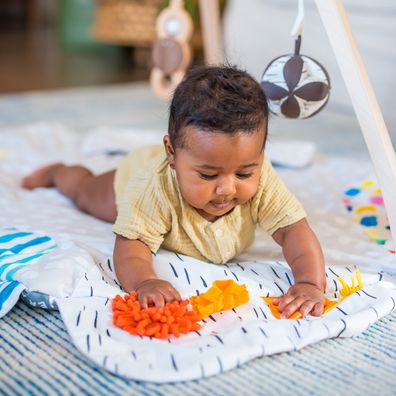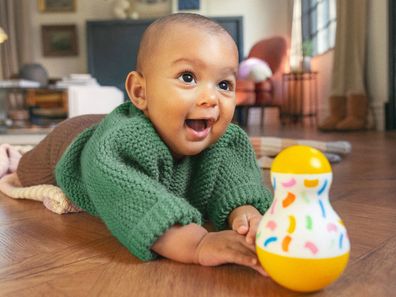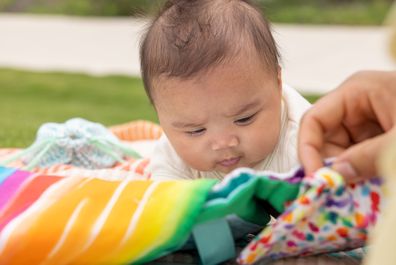Newborns and play: An expert answers your burning questions
By Nikolina Koevska Kharoufeh |
T?here are so many things to figure out when you become a first time parent.
How to change nappies, how to bath your baby, when to put them down to sleep and what on earth the best burping technique is...
One of the other more confusing parts of a newborn's life is 'play' 每 the big question being just how you are meant to play with such a tiny little human?
9Honey Parenting spoke to ?Gabrielle Felman, Director of Child Development at Lovevery, to gather the answer to this and all your other questions about the adorable topic.
READ MORE: The best deals on Amazon you can't miss out on

When can you start playing with a newborn?
Right away! Play is all about connection, especially in the first months of life.
It is one of the most important ways to nurture development and to foster relationships with caregivers. It's hard to imagine your sleepy little baby actively learning, but that's exactly what they're doing.
During wake windows your baby is spending their time taking in the smells, sounds, and sensations of their new environment. And, they are building their visual skills 每 vision is a new sense for them.
Play for newborns can be anything from laying on a safe playmat watching trees sway, to listening to you sing while you change their nappy, to skin-skin time after a feeding.
When you have a newborn, simple forms of play can help them build brand new neural connections〞while connecting with you.
READ MORE: Music legend dies following 'long illness'

Best play/activities for newborns?
Your sweet baby is fed, rested, and alert. Now what? Here are some easy ideas for their first playtimes (always with your supervision).
For help with getting your child started, Lovevery have designed stage-based play essential kits which start from newborn age.
Black-and-white contrast images
Vision is the sense that is least stimulated in the womb, so your baby is hungry to practice looking at things.
Start with simple black-and-white images about 12 inches away from your baby's face (about the distance from your wrist to your elbow).
Hold the images steady and try not to switch them until your baby looks away, a sign that they may be losing interest or they need a break!
READ MORE: Lizzo facing more allegations after bombshell claims
Tactile play
Stimulating your baby through touch and gentle pressure fosters the development of body awareness and stimulates their sense of touch while helping you connect and bond.
To play, place a baby washcloth, silky scarf, or a mitten over a few of your fingers and use it to gently stroke your baby's bare feet, hands, belly, and face.
Repeat this often to help your baby learn what the different textures feel like against their skin and begin to associate each body part as theirs.
Talking, singing, and reading
It's awkward to talk to someone who doesn't yet talk back, but research shows a direct link between a child's intelligence and the number of words spoken to them.
In the first few months, your baby is constantly listening to the intonation, rhythm, and patterns of your voice.
Even though they can't understand what you're saying yet, their brain is laying the groundwork for acquiring language.
Narrate things you do with your baby while you change their nappy, get them dressed, and give them a bath. House tours are another great way to talk to your baby.
Sing favourite songs while you are face to face. And, incorporate books into daily routines and tummy time!
READ MORE: The $18 Kmart buy that transforms long flights
Side lying
Both physical and occupational therapists recommend side lying to help prevent flat head syndrome.
Side lying helps your baby build strength in their back and belly, and also encourages them to bring their hands together 每 an important developmental step.
Roll up a blanket and prop your baby on their side, using the blanket to support their back 每 be sure to supervise them.
Place a black and white card or a baby-safe mirror in your baby's line of sight. Eventually, switch them to their other side, and repeat.
Follow your baby's cues 每 side lying may not last long. If your baby gets fussy, give them a moment, then pick them up and comfort them. Once calm, you can try again.
READ MORE: Ex-hotel manager shares what items we're 'allowed' to take

Things to do with a newborn out of the house?
Getting your baby, and yourself, out of the house is a wonderful thing for both of you 每 the sunshine, fresh air, natural sensations like the wind, and sound of cars.
Outside play doesn't have to be complicated! Here are a few ideas:
- Setting up a playmat or a baby blanket on the grass and bringing one or two playthings for your baby to explore.
- Setting up a playmat or a blanket on the grass and letting your baby do tummy time or back time and watching the sky and trees. Treat yourself and read a book or magazine while they explore next to you.
- Take a walk with your newborn in the pram or a carrier. Talk about what you hear and see.
READ MORE: De'Longhi slashes prices for massive kitchen appliance sale
What do babies like to play with?
Toys with flashing lights and loud noises can capture a baby's attention and can support cause and effect, but they tend to shut down opportunities for problem-solving and imaginative play.
Lots of lights and loud sounds during play can also lead to a baby becoming overstimulated more quickly.
Open-ended playthings and those that allow your baby to 'work' to make the toy function will support children's natural curiosity and interests at each stage of their development.
Think of playtime as any time your baby is exploring a safe object, a person, or their environment. And, playtime equals learning and development for young children because it is their work.
READ MORE: Child star dies after five-year disappearance

When should you start tummy time and for how long?
The earlier the better! Research shows that tummy time supports development of your baby's motor skills through strengthening their head, neck, shoulders, arms and trunk muscles.
The World Health Organization advises that babies who aren't yet mobile get at least 30 minutes per day throughout the day while awake.
This includes newborns 每 Australia's Department of Health recommends supervised tummy time for full-term babies soon after birth.
It's necessary to always supervise your baby at all times. When your baby is awake, start tummy time at an inclined and supported position at first 每 this can be a less stressful way to support them.
For example, try laying your newborn over your lap with your legs crossed, with their head higher than their hips, or have them up against your chest when you're in a reclined position.
Once your newborn's umbilical cord stump falls off, you can start placing your newborn on their belly on the floor.
Once your baby is one month old or older, you can consider offering frequent, short sessions during each awake window during the day.
Each session can consist of several repetitions of rolling your baby into tummy time and rolling them out for brief breaks and then rolling back in for another few seconds or minutes, slowly building up to the recommended time.
For a daily dose of 9Honey, subscribe to our newsletter here.





